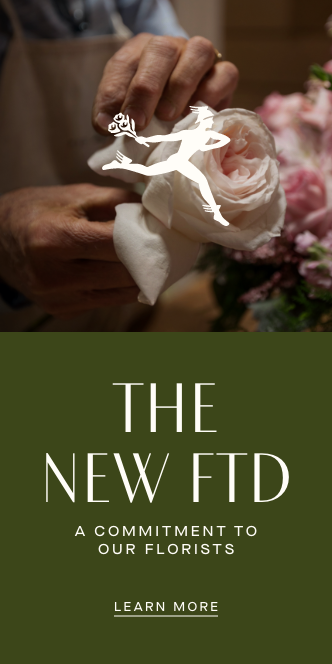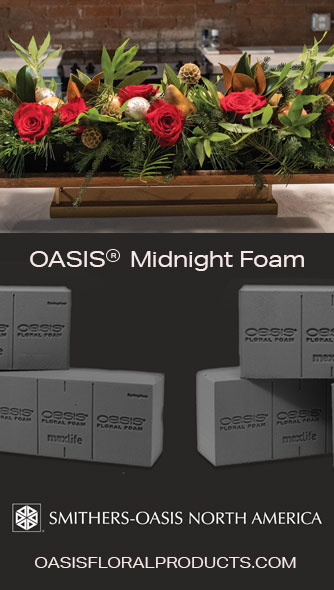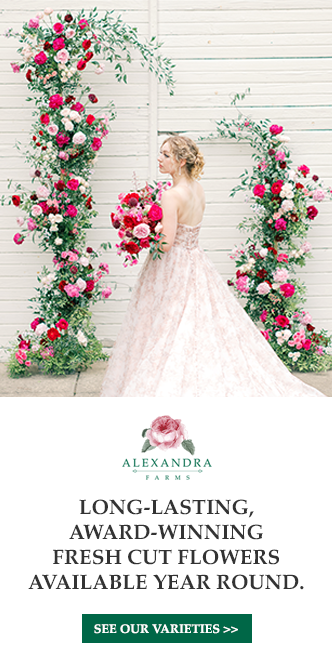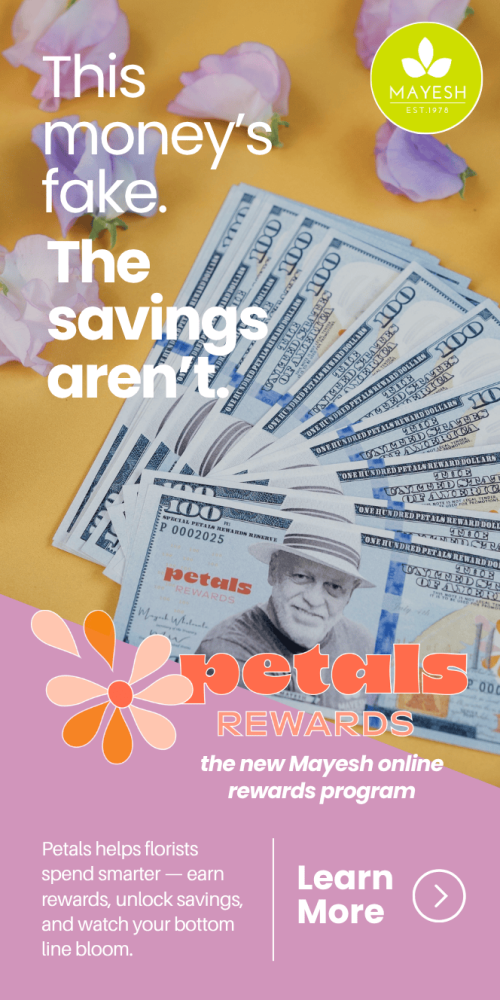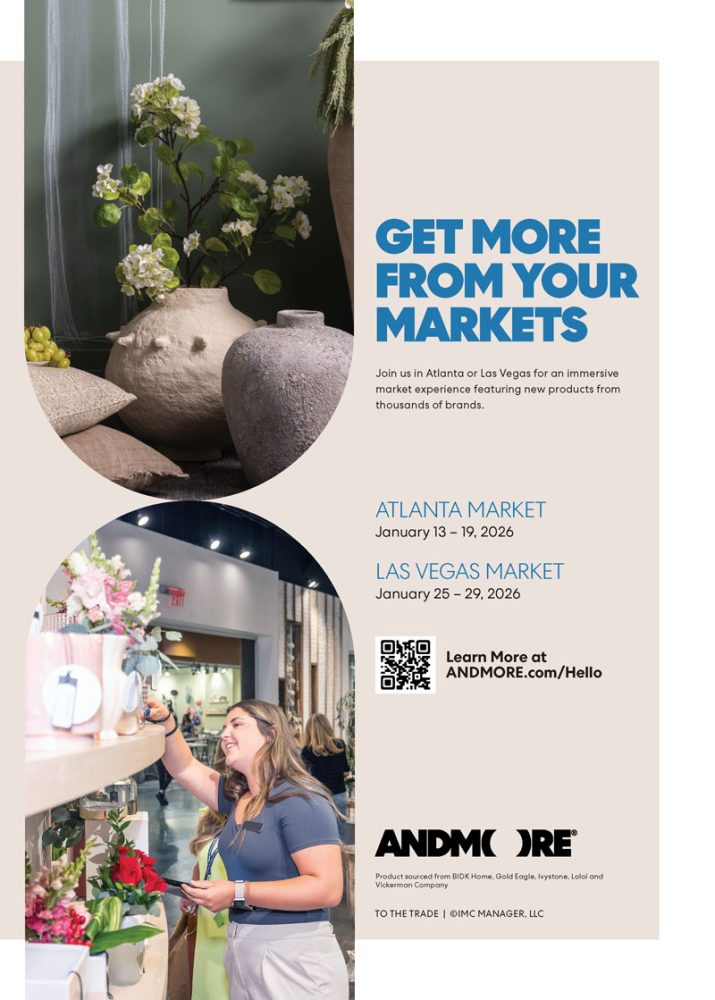Making the case about the importance role containers play in creating the perfect floral designs
By Jill Brooke
At the recent Fleurs de Villes “ARTISTE” show in New York City’s Hudson Yards, florist Lorena Eni, owner of LEF/Lorena Eni Flowers in the borough of Manhattan, and her team were busy using double-faced tape to paste wheat strips along a rectangular glass vase. Inside, they expertly added spectacular taupe tulips tipped in white along with soft grey hellebores for a dreamy effect.
In fact, judges, which included me, couldn’t help but gasp at the loveliness of the vases surrounding the 10-foot-tall flower-dressed mannequin inspired by the work of Italian fashion designer Elsa Schiaparelli. It was part of the reason that this show’s mannequin won applause from not only the judges but also the public.
“Vases,” says Eni, help “create the mood” of any creation.
The famous fashion photographer Francesco Scavullo once said that just like a museum painting needs a great frame to dazzle; the same can be true about vases and other flower vessels.
Most florists understandably buy quantities of reliable gold or glass vases in a variety of shapes. These vases line wedding tables or larger versions for bar areas and are purchased from reliable vendors.
For example, Accent Decor, Momma Pots and OASIS® Floral Products, a division of Smithers-Oasis, all have a wide range of vases and are always coming out with new products. Accent Décor, for example, offers collections of on-trend vases and vessels that bring flower arrangements to life and stand out on their own. The glassware line by OASIS® Floral Products comprises dozens of different shapes favored by florists. We spoke with Kelly Mace, CFD, AAF, PFCI, marketing manager at Smithers-Oasis, about the new 8-inch-tall clear glass “Haven Vase,” which features clean sleek lines and a minimalist aesthetic.


Adding to the requests now from florists are vessels that are environmentally friendly and sustainably produced. According to a study from the Sustainable Wedding Alliance, a collective of businesses with the purpose of creating a more sustainable, environmentally conscious wedding industry, 98 percent of nuptial couples said that sustainability was a factor when planning their weddings, with 78 percent saying it was important or very important to them.
Danica Mirrasoul, operations manager of Momma Pots in El Cajon, Calif., says she’s seeing an uptick in “high-quality porcelain vases and pots” being used by florists needing vessels that are “stunning and sustainable, able to keep up with today’s eco-conscious couples while also highlighting floral masterpieces.”
“These vessels are durable and reusable, and they practically shout “sustainability,” making them a top choice for modern brides who care about more than just the blooms,” Mirrasoul says. “With a palette of trending colors that play perfectly into the rise of monochromatic bouquets, they make it a breeze to match any wedding color scheme with effortless style.” Mirrasoul calls them “the ultimate floral sidekicks you never knew you needed but now can’t live without!”

Also trending are containers in two-tone and multi-hued colors, which enable the flowers to “pop” by expertly using them synchronisticly. Furthermore, with flowers being so expensive, not as many are needed. And of course, the vases are recyclable and can be easily amortized.
So, how many vases do you have as a florist? We would bet not enough. They are essential accessories for your success. All florists need to have a variety of vases in their repertoires for wedding work. Tables, of course, must have consistency. While a row of vases for a table can be the equivalent of the perfect black dress in your wardrobe, have a few that are the stand out “accessory.”
An area for creative opportunities is the bar. Why not purchase a large unexpected vessel that becomes a focal point. The flowers don’t always have to be the star. They can be the “side dish” to a visually special vessel. Plus, it takes less flowers to make a big impact.
Leatal Cohen, owner of Pic and Petal, a floral-and-event-design and photography firm in Brooklyn, N.Y., is known for her colorful waves of blooms in wedding work. She, like many florists, say that collecting vases helps her business. It is also an opportunity to stand out from the crowd of other florists.
“For each event, I look at the environment it’s in and the colors in the room, and then think of what vessel I should use,” Cohen says. “Will the vessel be complementary and also different?” Thus, she says, she does shy away from traditional clear glass vases. While a big fan of Accent Decor and Jamali Garden, she says she is also sourcing Etsy and thrift shops for vintage vases. In fact, vintage vases are often quite inexpensive and accessible in thrift stores. In the right hands, these vessels become not only beautiful but modern when filled with unexpected flowers. They also hide design mechanics like chicken wire.
“For a dinner party or corporate event, vintage vases can be used effectively,” Cohen says, “enhancing your brand.”

Pic and Petal
Some of the vintage and even ancient vases one might find can also hold histories. Much of the human experience is etched on these vases—especially the Grecian ones—and reveal cultural connections. Become knowledgeable about the histories of the most timeless and classic containers, and infuse your pitches to wedding and event clients with a bit of the information you discover. For example, did you know that the ever-popular blue-and-white porcelain originated in China in the 14th century, but that in the early 1600s, pieces made their way to the Near East and Europe via the Dutch East India Company? Influenced by the Chinese porcelain, potters in the Netherlands city of Delft soon began manufacturing their own versions, which became known as Delftware. There are also Japanese and Islamic/Persian adaptations of the classic blue-and-white porcelain.
The same advice goes for flowers, as well. Incorporate flowers with origins and cultural connections related to the containers, creating fascinating and cohesive stories with your floral designs.
Florists can also benefit from accessing the special mementos from their clients. Jim Osburn and Michael Grim, co-owners of The Bridgehampton Florist in the Long Island, N.Y. hamlet of the same name, often scour. Osburn and Grim, who do lots of in-home work, often try to personalize their arrangements. Clients’ candy dishes and urns are great resources, they share. “They make an event feel more ‘homey’ and personal versus industrial,” Osburn says. Furthermore, they also choose vessels that complement the tablecloths in clever ways.
Consider the British florist who asked her client for special teacups that belonged to the client’s grandmother, for a birthday party for the grandmother. Lining the table with ivory chamomile flowers arranged in the teacups created a memorable tablescape. Or perhaps your client inherited a box or a vase from another relative. Maybe a vase was bought on a honeymoon or special trip. Ask about items like these in sales conversations.
The more you interact with your clients and incorporate the “memorable” into your work, the more bonds you will create with those clients. It becomes an interactive exchange. It is surprising to me how few times florists ask their clients if they would them to use personal containers and incorporate other personal items into the floral designs.
Also, be expansive in realizing how the unexpected can be a creative opportunity. Cake stands often have interesting motifs. Collect them. One of my cake stands makes me laugh and reminds me a bit of Dorothy in The Wizard of Oz. Always a good start. It is literally my base, my starting point for many designs, and it becomes a conversation piece every time I use it at events—and I also keep it at home.
Every flower shop has its ebbs and flows, but you need to know which flowers you most consistently purchase and sell for events. Then start collecting vases, stands and bottles to complement this collection of flowers.
As the creative writer, philosopher, social evolutionist and founder of Descriptionari.com Angela Abraham so intuitively writes, “The vase is beautiful in its simplicity, just as a canvas is simply there to hold the art so lovingly applied, it allows the flowers to take centre stage. They are so bold in the room, and all the more wonderful for it. So many vibrant hues dance in a breeze that saunters in through open doors and windows, together a festival for eyes who care to see.”
Which is why, of course, a vase should never be an afterthought. It is the costar along with the flowers.

Pic and Petal
Cover image credit- Floral design by Leatal Cohen Pic and Petal










